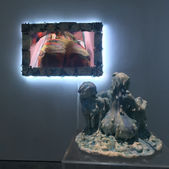AMIA YOKOYAMA
Midst of Bliss
in lieu gallery
2021

Excerpt from "Inside and Out I am Surrounded By It" - full runtime 11min












There is a thawing, muddy utopia in Amia Yokoyama’s work. Bodies are hardened in the glaze of clay and softened in the silt of the digital render. Pleasure is a leaking encyclopedia. The internet is a mythology. Friendship swarms, like a gaggle of clouds or a team of insects. To quote an anonymous user, “A captured prey will be enveloped by the entire slime and given rapturous pleasure. The excess portion of their body that doesn’t form the shape of a woman will accumulate under their feet.” We gather in pools, indistinguishable and silver in the light.
When she sends you a link to the community-aggregated wiki for the manga “Monster Girl Encyclopedia,” pay attention. It’s a poem, in the most prayerful sense. At first glance, it seems like a catalogue of all the different ways to draw a body, and maybe to have one. Humans have invented so many different kinds of girls, they need many different kinds of encyclopedias, and there are still more, uncounted, more ways to suck, sink, and supplicate before the infinity of our variance. From here, infinity looks flat and wet, like a field. I am comforted by the pages and pages of monsters having new kinds of sex with each other, and sex with their inventors, and sex with me, in the space of possibility that unfurls as I click through.
Amia Yokoyama has sent me to ‘Slime,’ a gelatinous creature that takes the form of a girl sometimes; other times, they melt into a new shape, or absorb other sibling slimes, or split into baby slimes, or merge into one slimy clump, dissolving into a translucent, gorgeous plural. The encyclopedia informs me that they survive off semen, milk, sweat, saliva, or sometimes just the abstract concept of liquidity. Relatable. Yokoyama is studying the slime-monster-girls (such a delicious tautology, words kneaded into a slab) and she is making them, but they are made of something hard and still and fragile: porcelain. Her slimes are not slime itself but a totem to it, stoic guardians of another kind of creature, another kind of life.
There is motion, too, but a very specific kind: falling, continuously. Other times the girls in her video (Yokoyama calls them “avatars”) are growing, burying, planting, conjuring, walking, expanding, opening wider and wider until we glide through their bodies like driving through a tunnel. Every week the video is re-edited by her, mutating and shedding, like a body. The avatars are 3-D models that fans upload which Yokoyama has sourced and sculpted, made squishy and elastic, and then painted with scans of paintings, paintings of her animations. The screen and the canvas eat each other. Head to tail, muscles flickering.
Yokoyama texts me a list of images that coat the bodies of the freely downloaded girl shapes: “swarms of bees, swarms of ants, swarms of smoke (from volcano or forest fire), subtitles (fragments of sentences that you can read on their bodies), screenshots of the moments in anime when a character’s body loses its form, and transforms into something more ambiguous… you know those moments?” The avatars wear another’s formlessness like a dress. I know the moments. A ghostly insect hovers above them, as their soft knees traverse the blank field of the digital. They fall, again and again, death dropping from the heights of nowhere, suspended and ecstatic. This is another kind of prayer.
- Audrey Wollen